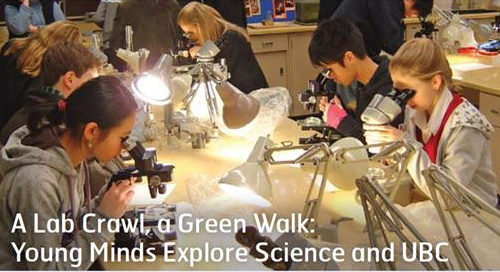This article was originally published in Synergy Journal of UBC Science, Issue 01/2010. Read it in its original form.
Opportunities to discover tree taxonomy, superconduction and life sciences greeted high school students attending the regional science fair at UBC Point Grey campus.
Some of the students who attended UBC Science lab tours and demonstrations at this April’s Greater
Vancouver Regional Science Fair (GVRSF) might just call the experience a walk in the park. But the aptly named A Walk on the Green Side—a 45-minute tour that let grades seven to 10 students discover the tree and plant life on campus—took in more than botanical life.
“I love the university and think that potential students should experience all of it,” says Shona Ellis, senior
instructor with the Dept. of Botany, who has put on the tour for the past five years. “So I like to talk not only
about the botanical life of Point Grey, which is considerable, but the history of the campus and its architecture. Not many people know that in the early ’60s the entire campus was designated a botanical garden.”
Not surprisingly, Ellis’s tour takes in the magnificent elm outside UBC’s Physics and Chemistry buildings, the many trees that line the campus malls, and the famous upside-down tree (a Camperdown Elm). But Ellis also includes details on some of the memorable buildings on campus, including the Ike Barber Learning Centre, the First Nations Long House and the Chemistry Building, which was the original Science Building.
Close to 20 tours and demonstrations were put on by UBC faculty members, instructors and graduate students, as hundreds of high school students descended on campus to compete in the GVRSF. Demonstrations ran the gambit from microscopic zoos to the world of computers.
In addition to Ellis’s “green” walk, UBC Science tours took students to one of the premier facilities on campus, the Advanced Materials and Process Engineering Laboratory (AMPEL). In the AMPEL Building, demonstrations delved into the world of physics.
Physics & Astronomy’s Walter Hardy wowed students by levitating a magnet above a sample of superconducting material cooled by liquid nitrogen. He also demonstrated superfluidity in liquid helium, a point at which the helium is able to overcome friction.
“These demonstrations are a very direct way of exhibiting some of the really spectacular things that occur in
matter,” says Hardy, professor emeritus with the department. “They’re typically things that I think everyone should see at least once in their life.”
UBC’s Michael Smith Laboratories and Centre for High-Throughput Biology (CHiBi) welcomed almost 30 students to tours themed around micro-organisms, mammalian cells and new technologies. Offerings included a demonstration of CHiBi’s fluorescence microscopy system.
“Students become very enthusiastic when they’re asked to perform hands on tasks during the lab tours,” says
Véronique Lecault, a Chemical and Biological Engineering PhD student who helped put on the tours.
Lecault also coordinates the UBC Let’s Talk Science Partnership, which connects UBC science and engineering students with school teachers to deliver hands-on and engaging scientific experiments in classrooms.
“I’ve seen students not wanting to leave a lab before they had a chance to write their name with a laser dissection microscope! The best reward for the researchers who volunteer their time is to see the ‘spark’ in the eyes of the students when they learn something new and exciting about science.”
Lecault notes that UBC science students are heavily involved in outreach activities leading up to the
science fair. Supported by a Faculty of Science Outreach Grant, and in partnership with the UBC Learning
Exchange and Let’s Talk Science, more than 50 undergraduate and graduate students mentor at inner city
secondary schools, helping students get their science fair projects up and running.

